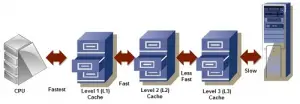The cache (pronounced “money”) is a small, fast cache. It is designed to speed up data transfer and instructions. It is located in or near the CPU chip. It is faster than random access memory, and the data or instructions that the CPU has recently or most frequently used are buffered.
When the CPU is first used, data and instructions are retrieved from random access memory. A copy of the data or instructions is cached. The next time the CPU needs data or instructions, it will first appear in the cache. If the required data is found, it will be retrieved from the cache instead of the main memory. Accelerate CPU work.
Types/levels of Cache memory
A computer can have several different memory levels. The level number represents the CPU distance, with level 1 being the closest. All levels of memory are faster than RAM. Cache is always the fastest CPU cache, but it is usually more expensive and stores fewer data than the cache level.

Level 1 (L1) cache or foremost cache
It is the main type of cache. The L1 cache size is very small compared to other sizes ranging from 2KB to 64K, depending on the processor. It is a built-in microprocessor register (CPU). First, the instructions requested by the CPU are searched in the L1 cache. Examples of records are batteries, address books, program counters, and so on.
The second level cache (L2) or the secondary cache
L2 is the second type of cache. The L2 cache size is larger than L1 between 256 KB and 512 KB, and the L2 cache is located on the computer’s microprocessor. After searching for the L1 cache instructions, if it is not found, the computer’s microprocessor will find an L2 cache search. High-speed buses operate until the cache is stored.
Level 3 cache (L3) or base memory
The L3 cache is larger, but L1 and L2 are faster. Size ranging from 1 MB to 8 MB. In multiprocessor processors, each core may have separate L1 and L2, but all cores have a common L3 case. The double speed with L3 RAM.
Importance of cache memory
The cache is located in the path between the processor and memory. Therefore, the cache has a shorter access time than the memory, which is faster than the main memory. The access time to the cache is 100 ns, while the main access time for the memory is 700 ns. Caches are very expensive and therefore have limited capacity. The cache was previously supplied separately, but the wizard has the same cache for the same chip.

The need for caching is due to incompatibility between main memory and CPU speed. Professional attention is very fast, and access to memory is quite slow. Therefore, regardless of how fast the processor is, the processing speed depends on the main memory speed (current power is the weakest link strength). That is why the cache provides faster processor access time.
The cache stores programs (or parts of them) that are currently running or programs that can run in a short period. The cache also stores temporary data that the CPU may need to function frequently.
The cache works according to different algorithms that determine what information to store. These algorithms calculate the probability of identifying the most needed data. This is based on previous observations.
It works as a high-speed buffer between the CPU and main memory and is very efficient for data buffering and processing. Because the cache is faster than the main memory, it increases the processing speed by generating the required data and instructions in the current cache. The cache is too expensive and therefore has limited capacity.


















